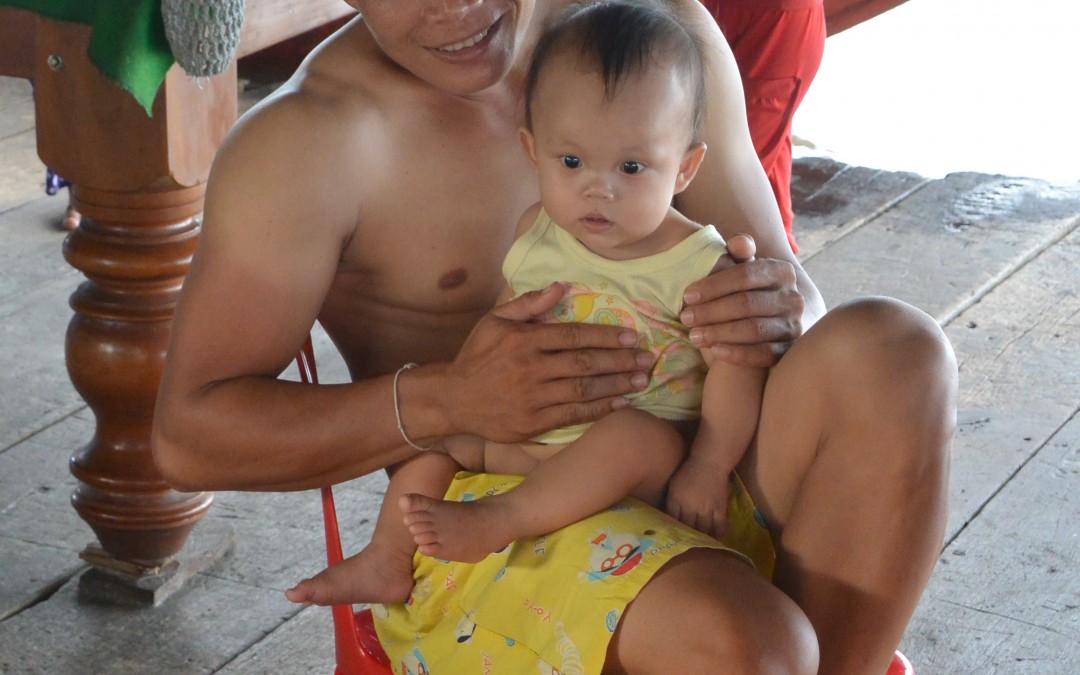
by Nick | Apr 15, 2021 | Blog, Kayak
Prek Toal The Hard Way (by kayak)
The current was flooding up the channel and a Southerly headwind was blowing as we set off from the boat station at Maichrey. Clouds grew dark then faded or pulled down by the weight of the moist air they released heavy drops of rain, which exploded around our kayak and soaked us from the start. ‘Tow na Bong?’ They asked Buntha. ‘Prek Toal,’ ‘oey chngai!’ very far they shrieked.
With the wind and the current against us we seemed to be standing still but eventually made it to Maichrey Pagoda, where we rewarded ourselves with the ‘scrogg’ of cashews and dried apricots I’d brought. The children watched as the aliens (well me) rested on their spacecraft before heading for brave new worlds, in our case Prek Toal.
 Maichrey Launch with Buntha
Maichrey Launch with Buntha
The easy but longer route was via the open lake, the shorter route turned out to be straight ahead over the flooded scrub but we didn’t know the way. The long tailed fibreglass narrow boats with their mind numbing engines have replaced the slow chug of the heavy wooden craft but now their deafening echo was a welcome reassurance that we were going the right way. The Prek Toal telephone mast and later the roof of the tall school (on stilts) confirmed it.
 Prek Toal in sight
Prek Toal in sight
We emerged into the village beside the pagoda. ‘Mow pi na?’ they shouted. ‘Battambang,’ Buntha replied. We were so strange they weren’t sure whether to believe that we were paddling the 90 km to Battambang*.
*Not so strange as later we did, see The Sangke River kayak entry in the website blogs
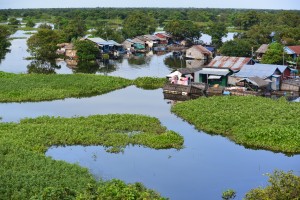 Prek Toal Village
Prek Toal Village
Veasna Buntha’s wife’s family home was a flotilla of houses and shops combined with a pool hall, crocodile cages and the largest floating garden in the village, which reminded me of the dreamtime animal island in the Life of Pie.
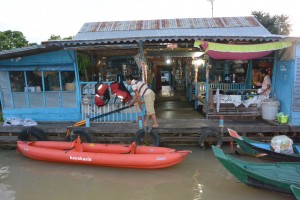 Our Prek Toal Home-stay
Our Prek Toal Home-stay
Floating pool hall with concrete table, pot bellied brother in law playing with 10 year old girl for 2000 Riel.
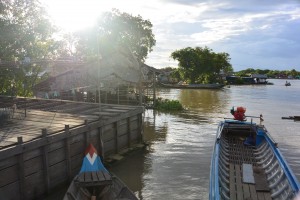
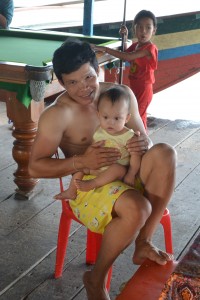 Looking up the channel behind Veasna’s house and baby Buntha
Looking up the channel behind Veasna’s house and baby Buntha
Colours come out as the sun goes down and the motorboats make a dance with each other across the channel. 3 families together generator so we had light and the children a TV. They watched the KTV show and made the motions in time with the plastic dancers on the television. The noisy long tails pulled up to drop off the pool players.
Delicately baked fish fresh from the lake, chili, peanut and lemon sauce and with vegetables washed down with copious quantities of ice-cold Angkor beer, after a long kayak we were at peace with the world.
My bed was in line of the breeze next to the crocodile cage and around the corner the toilet ‘au natural’.
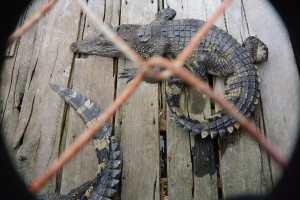 My room mates
My room mates
The generator ran out at 10 and the shuffling of the crocodiles and ringing of the insects took over from the noise of the pool players sending me to sleep.
 Setting off back to Maichrey
Setting off back to Maichrey
Lazy bones, I was the last to wake to a cool grey morning, great for kayaking. We loaded our boat, bade goodbye to Buntha’s family and paddled the short distance to a breakfast place for noodles and beef.
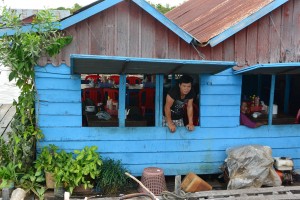 Breakfast
Breakfast
The day was calm and the wind with us so we decided to paddle the longer route via the open lake. Sustained by ‘scrogg’ and innumerable bottles of water we tried a short cut through the trees at the edge of the lake. Water hyacinth blocked us at each turn until we found a break in the weeds that lead to a floating camp of illegal fishermen. Unperturbed by the harmless barang* they pointed the way to the lake and we slogged it back to the Maichrey boat station. *Barang lit Frenchman is the term used for all foreigners
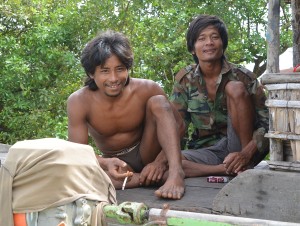 Illegal Fishing Camp
Illegal Fishing Camp
Indochineex Adventures in Cambodia is pleased to take guests to the floating village of Prek Toal and the flooded forests of the Core Bird Reserve. We kayak between the trees back to Prek Toal Village for lunch on a day trip or overnight sleeping in a home stay as per the description above. We’d be delighted if anyone wants to do the kayak across the lake to the village but given the state of our shoulders the next day we suggest a motorboat back.
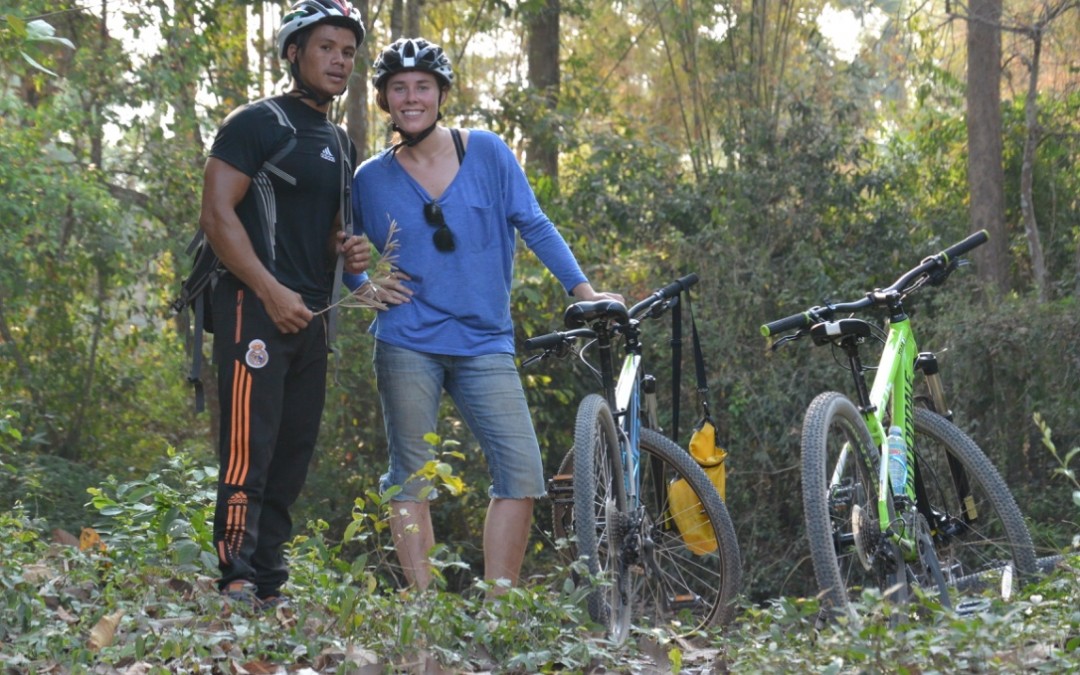
by Nick | Mar 22, 2021 | Bike, Blog
Countryside Exploration Cycle
The Siem Reap countryside is changing all the time as the town spreads but its not long before the hard road becomes a track and the houses are raised on stilts.
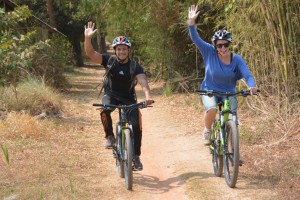 Lors and Taylor cycling one of our mountain bike routes around Siem Reap
Lors and Taylor cycling one of our mountain bike routes around Siem Reap
A line of trees shades a canal as it crosses the landscape. Dug to control the flooding lake as it advanced across the countryside then channel the receding water to rice fields surrounding the small villages that dot the floodplain.
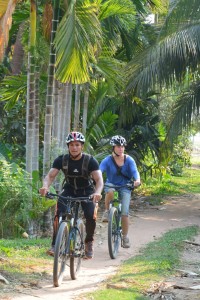 Rural path shaded by beetlenut palm
Rural path shaded by beetlenut palm
Mountain bikes are the ideal way to explore this varied landscape, cycling along avenues of bamboo through the backyard of farms shaded by beetlenut, sugar and coconut palm.
We’ll stop at a smallholding for a coconut, which our more agile guides can climb the palm tree to pick. And meet the family, cows, pigs, chickens, ducks and the farmer to learn a little about how most Khmers live in the countryside.
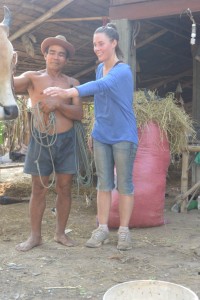
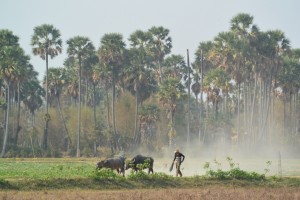
Taylor getting to know a cow & Water-buffalo feeding on paddy field stubble (below)
We’re cycling through the Angkorian metropolis. A millennia ago this land was feeding the armies of Jayavarman VII as he conquered South East Asia.
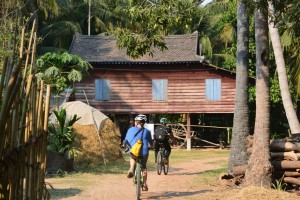 Khmer stilted house
Khmer stilted house
Despite the ravages of time, agriculture, war and weather there are many signs of a sophisticated civilization, none more so than the West Baray. It was the largest completely man made reservoir in the world until the 19th century and that’s where we’re going to finish our countryside exploration cycle.
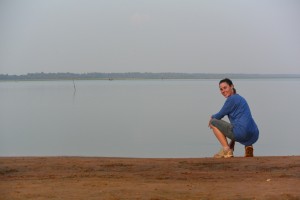
Cold beers and Khmer snacks await as we lean up our bikes and sit beside the water watching fishermen in simple wooden canoes out on the Baray.
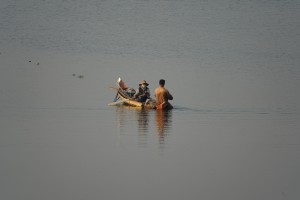 The West Baray
The West Baray
We have many routes, which we vary according to the season and how far and long you want to cycle. We can focus on a rural way of life or search out the secrets of Angkor hidden in the countryside. Morning cycle rides with picnic lunches beside the water or sunset beers / cocktails at the Baray watching the sun sink in the West.
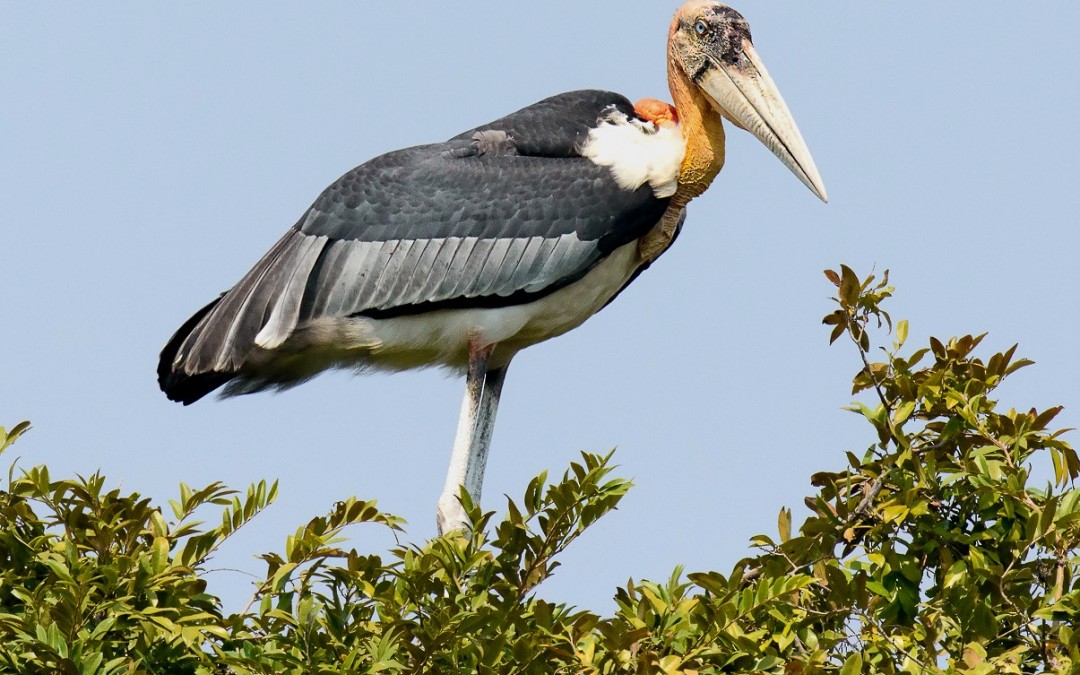
by Nick | Feb 25, 2021 | Blog, Conservation, Kayak, Uncategorized
Prek Toal on finfoot
The incredibly rare milky adjutant lived in Prek Toal and it was my mission to save it even before I got to Cambodia and realized there isn’t a milky adjutant it’s a Milky Stork and a Greater Adjutant. Undeterred enthusiasm intact, Prek Toal was at the heart of why I’d come and where I was going.
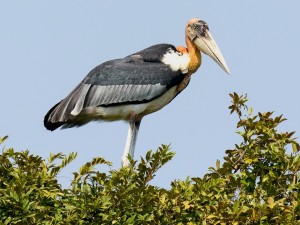 Greater Adjutant inside the Core Bird Reserve.
Greater Adjutant inside the Core Bird Reserve.
The Core Bird Reserve did not disappoint. A two hundred square kilometer water world of open forest emerging from The Lake during the ebb, it seemed untouched and unvisited. A haven for the flocks of large birds that flew past our boat; pelicans soaring high on the thermals or sailing galleon like across the lake. Oriental Darters and cormorants flying in formation, plunging into the water with their spear like beaks to pluck out fish. And the storks perfectly poised in the tree canopy, ruled over by the largest of them all, the Greater Adjutant.
Over 200 species have been recorded inside the core bird reserve so every size, shape and color has adapted to take advantage of the hierarchy in the flooded forest.
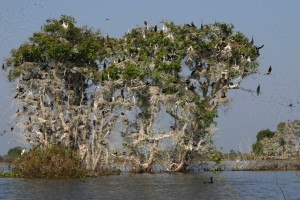 Cormorant and Oriental Darter colony with their white chicks. Photo Nick Butler
Cormorant and Oriental Darter colony with their white chicks. Photo Nick Butler
Prek Toal Village is fantastic in its own right, hundreds of wooden houses floating on clumps of bamboo clustered along the river banks in the dry season when the lake is low or spread out into the forest during the flood. The village economy revolves around fishing; subsistence for the poorer families in the floating shacks. Midscale for those that can afford the apparatus and the bribes to fish inside the core bird reserve. And commercial where migrants work for the Bong Thoms (powerful people) with fishing rights to the Lake. In February the fish fences fringe the flooded forest to trap the fish as they emerge from their sheltered nurseries beneath the trees.
Life on the lake is dictated by the annual pulse of water surging down the Mekong River. Silt caught in the current is carried from China through Myanmar, Thailand and Laos then deposited where the water slows South of Phnom Penh. The raised riverbed changes the direction of the flow from South to the sea now North to the great Tonle Sap Lake, filling it like a bath until the King pulls the plug at Bon Om Teuk, The Water Festival and allows the river to regain its normal route.
 Prek Toal Village during the flood. Photo Nick Butler
Prek Toal Village during the flood. Photo Nick Butler
The flood brings life in the form of fish that swarm into the flooded forests of Prek Toal to breed, spawn and grow providing much of Cambodia’s protein.
What can we say to our guests when we take them across the lake from Siem Reap to The Core Bird Reserve and Prek Toal Village?
We can explain the hydrological phenomena at the heart of the ecosystem and describe the adaptations both human and natural but it’s best to let people see for themselves and watch the wonder of this other worldly place work its magic.
That’s the scene set for our trip with Discovery Magazine onboard finfoot to capture the essence of what makes this place so special. Sally had come to look beautiful. Sam was there to photograph her looking beautiful. Daniel was there to write about her looking beautiful. The Core Bird Reserve and finfoot with logistical assistance from Indochine Exploration was the reason she looked beautiful, and incidentally why I was there.
It’s not easy to take a boat inside the Core Bird reserve but Buntha and Bo had persuaded the conservation team in Prek Toal to let us in. So we sailed through the trees to where Wildlife Conservation Society has built platforms in the canopy to monitor and protect the bird colonies. The water was at its height so we could see the submerged vegetation and the fish that swam between the leaves beneath us. It was too early in the year for the star of the show, the milky adjutant AKA greater but the trees were laden with black and white colonies of darters and cormorants with their creamy white chicks.
We paddled back in our kayaks over the yellow mats of saray, a tiny floating flower to where the water hyacinth clogs the channels into Prek Toal.
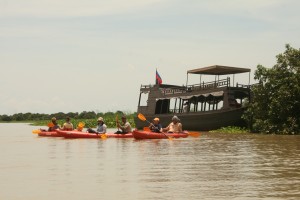 Kayaking at the edge of the Core Bird Reserve from finfoot. Photo Nick Butler
Kayaking at the edge of the Core Bird Reserve from finfoot. Photo Nick Butler
Clearing a route through the weeds we made it to The Sangke River and paddled across to The Saray Platform where the women of the village weave the dried stems of this invasive alien into handicrafts that are sold for the benefit of the poorest families in the village. There’s also a restaurant, you don’t have any choice, its fish fresh from the lake with vegetables and fruit traded from Siem Reap.
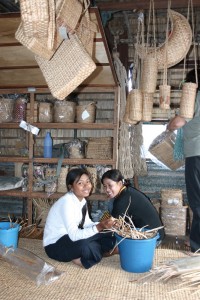

Women from Prek Toal Village weaving the stems of water hyacinth into handicrafts on the Saray Platform. Photo Nick Butler
We were sailing on finfoot, so we forwent the fish and rice in favor of lightly poached chicken and roast vegetable salad back on board.
The kayaks stowed and all aboard we stretched out luxuriously across the day beds on the upper deck, shaded by a canvas awning while the staff laid out our lunch boxes complemented by a chilled Chenin Blanc.
We’d been to the ends of the earth, a forest of flooded trees circled by flocks of birds. We’d paddled through a village untamed by time, as mesmerized by the villagers as they were by us.
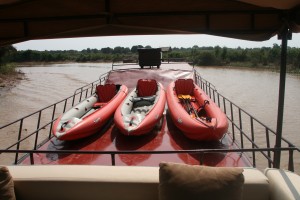 Kayaks stowed on finfoot
Kayaks stowed on finfoot
Indochine Exploration creates a very special day onboard finfoot. The Core Bird Reserve is Indochine Exploration’s flagship adventure, uniquely exploring this pristine environment by kayak with conservation experts.
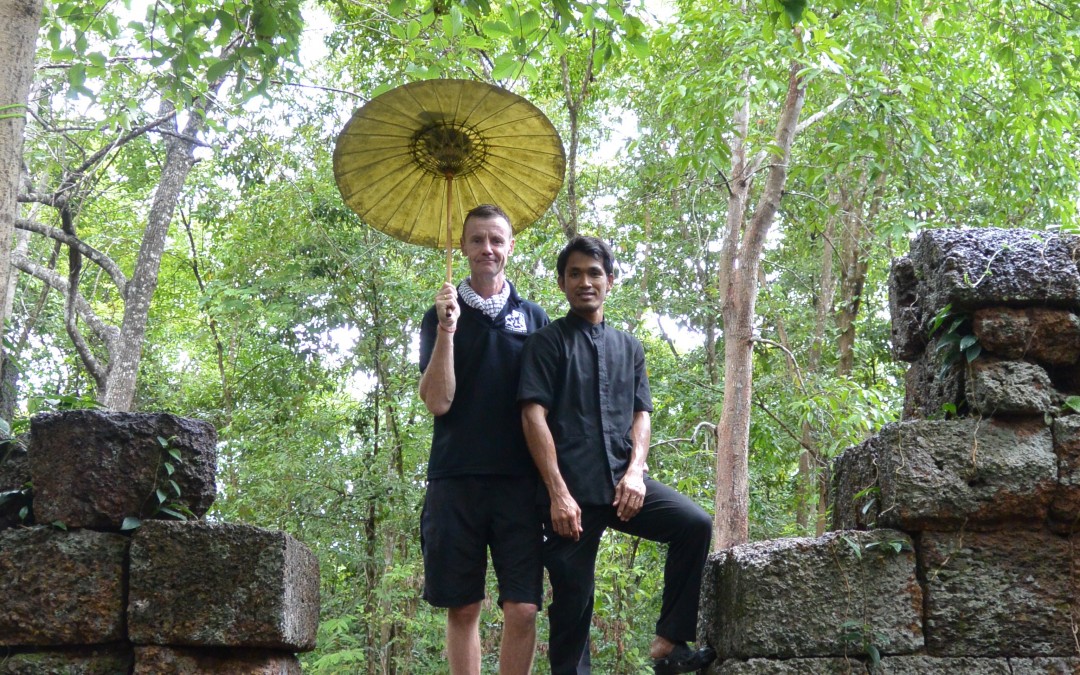
by Nick | Feb 16, 2021 | Angkor, Blog
Route 66 – An Angkorian Adventure
This is the story of a family’s adventures along an ancient Angkorian Highway in search of temples hidden in the forest.
A thousand years ago a canal was dug to ferry the giant blocks of stone that were used to build the temples of Angkor from Kulen Mountain where they were quarried. The canal has long since gone but the road that ran beside remains, now a sandy path for much of the way.
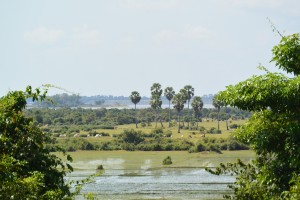 A rural landscape of sugar palm trees and paddy fields
A rural landscape of sugar palm trees and paddy fields
Our mission was to cycle where our families had not gone before, along the buffalo track past bright green paddy fields, between picturesque sugar palm trees and through Khmer villages of wooden houses built on stilts to stand proud of the floods. Children rushed out to get a glimpse of the strange ‘barangs’ (foreigners), shrieking goodbye and hello at random. Boys loosely herded buffalo that gently moved apart to let us through.
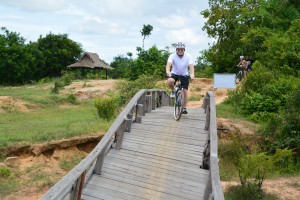 The River Bridge across the Kampong Phluk River
The River Bridge across the Kampong Phluk River
The bridge across the Kampong Phluk River was still strong but the piles had sunk to different depths leaving it twisted like a fairground ride. One by one we cycled across and onto our first stop. A hilltop temple with a pagoda in front constructed of stones looted from the ancient site. The 18 stages of Buddhist hell were graphically depicted on the outer walls. Sinners filed up to receive judgment as to how far they would sink into the eternal flames, which included the novel twist of attaching leeches to the nipples of ‘loose’ women.
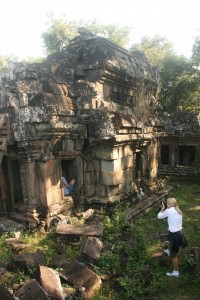 Chau Srey Vibol Temple
Chau Srey Vibol Temple
Grey clouds swelled and darkened until too heavy for the sky they fell as torrential rain. We reached the Jeeps just in time and set off for the next stage in our adventure.
Walking single file along the dikes between fields and through forest alongside the old road now flooded from recent rains. We came upon a clearing in the jungle and there lay the ancient ruins of the Tamarind Temple. We were lead through the portals of the Eastern Gate into a courtyard where a gleaming white tablecloth was adorned with flowers and the promise of a delicious lunch. Cold towels to wipe our sweaty brows and chilled coconut water to revive our flagging souls. To complete the cure Tern, in a smart black uniform popped the champagne cork and we toasted our adventure before the gazpacho was served.
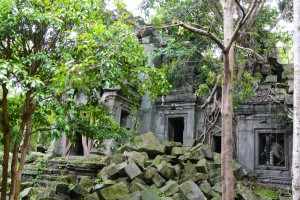 Banteay Ampil Temple
Banteay Ampil Temple
 The reward for our morning’s adventures
The reward for our morning’s adventures
There are many ways to leave a temple, Uri and I walked. The oxcarts were readied for Beth, Julie, Eve and Brian, cushions laid and tarpaulins hung as we bade them farewell. The sound of whirring rotor blades drowned out the crescendo of cicadas as the helicopter appeared over the tree line and settled onto the field next to the temple. We waved as Danny and Eric took off. Cycling is an option during the dry season and we can always kayak if it gets really wet.
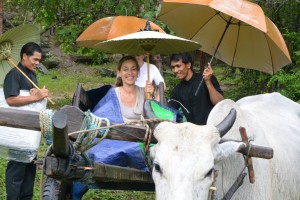
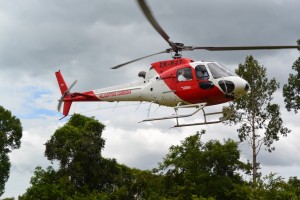 There are many ways to leave a temple including oxcarts (above), helicopters (below) and kayaks if its been raining.
There are many ways to leave a temple including oxcarts (above), helicopters (below) and kayaks if its been raining.
Indochine Adventures in Cambodia organizes bike, hike and simple picnics or champagne lunches in the Tamarind Temple with the different options described to return to Siem Reap.
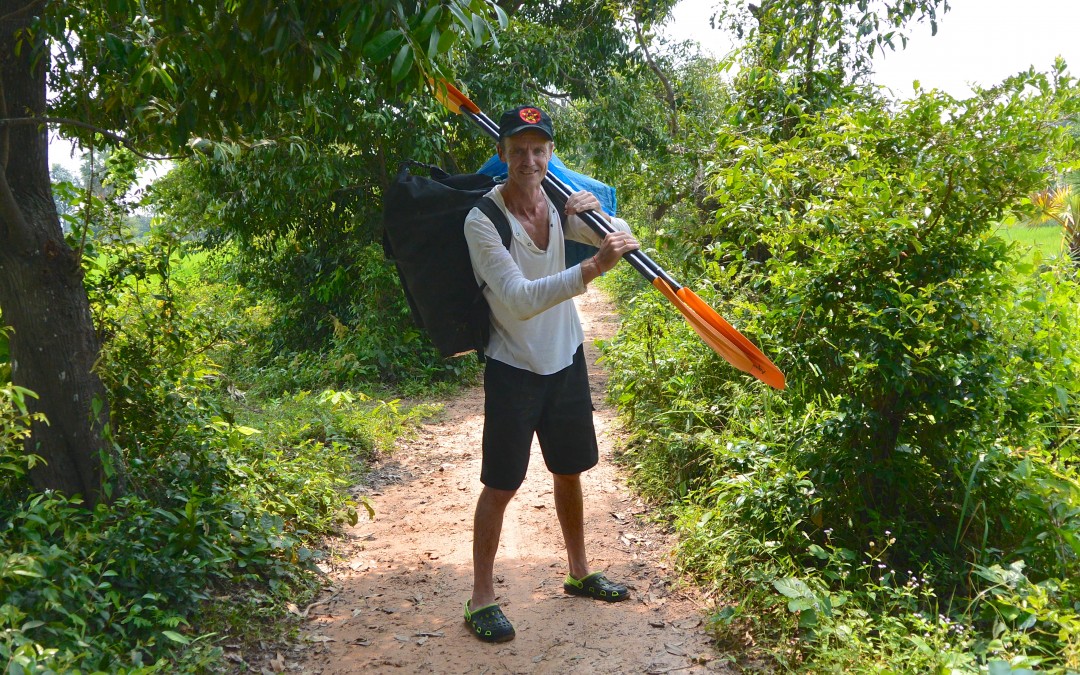
by Nick | Feb 2, 2021 | Blog, Kayak
Puok River (that wasn’t) Recce
‘To boldly go where most sane Khmer’s don’t.’
We knew the launch point beside the Angkor Crau Bridge though Sokun (tuktuk driver and Indochineex adventure guide) found it immensely funny that we hadn’t a clue where we were going.
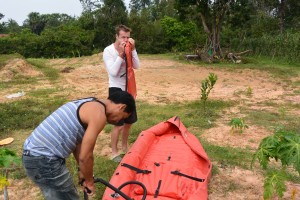

Nick blowing, Sokun pumping and Buntha launching
We inflated the kayaks on the banks of a channel that’s just been dug by Apsara. The channel in best Angkorian tradition aims to stop the town from flooding and restore the ancient water systems preventing the foundations of the temples crumbling.
An old man and a couple of children, a smaller than usual crowd attended the assembly of our spaceship and watched as we lifted off or rather splashed down, plonking our bottoms into the kayak, paddling down stream with Puok vaguely in mind.
The river was covered with a patchwork of lotus leaves and intense lilac flowers, the lush green banks were looked over by a few tall trees.
Our first obstacle was a fishing fence right across the channel, which we unhitched. The next low hanging branches, which we pushed our way through to find a straight stretch of water leading to a dam surrounded by quicksand. By the time I’d sunk past my knees I suggested to Buntha we find a different launch point.
 Lilac studded waterway
Lilac studded waterway
Back on the road or river, easy sailing or paddling to where we reached the plughole, a narrow gap in the banks that funnelled the river flow, directing it to spill in a big mess across the countryside.
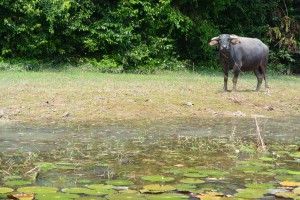 Curious locals
Curious locals
Valiantly we hauled ourselves through the rope like vegetation past flesh ripping rattan thorns and ended up in a leech infested swamp.
I went off to investigate and after 500 m found a small stream presumably heading towards the river, which we had rather carelessly lost at this stage in our expedition.
‘Tow na?’ Buntha asked a passing cowherd. ‘Arrrrgh,’ he was dumb. None the wiser we launched into the stream through a rice field then came to a halt as it too disappeared into impenetrable bush.
 Down the plughole
Down the plughole
‘Its all part of the adventure!’ I cried. Buntha looked nonplussed. We packed up the kayak and set off along a lovely sandy path in search of somewhere to paddle. A fringe of forest lay ahead, which in all fairness really should be the Baray, confirmed by a man in a ditch. Our way twisted between stilted wooden houses dishevelled with detail emerging on the road by the Baray.
Sokun where are you?’ ‘I can’t get my tuktuk round.’ ‘Nothing for it Buntha, lets pump up and paddle across.’ I said giving him an over cheerful grin, he responded with a theatrical groan.
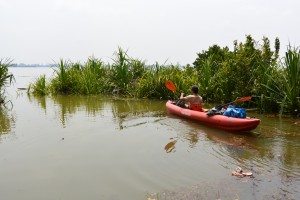 Setting off across the Baray & the South West Corner (below)
Setting off across the Baray & the South West Corner (below)
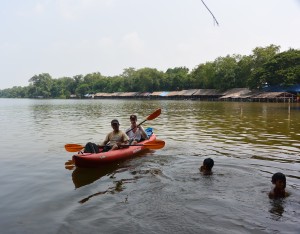
The vast waters of the West Baray stretched into the distance. ‘You said 2km,’ Buntha accused me. ‘2 + 2 + 2,’ I smiled slurping my beer and pulling off a piece of chicken as we swung in our hammocks in the Khmer resort at the South West corner of the Baray just spying the far side where we’d come from.
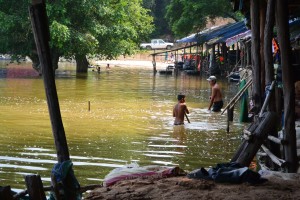 The Khmer Resort on the Baray
The Khmer Resort on the Baray
Indochine Exploration has cycling and kayaking adventures around the West Baray and Tonle Sap Lake along recce’d routes but we’re happy to explore and get a little lost with guests on foot, by bike and kayak.
*Puok to give some context is a small market town about 15km West of Siem Reap that tends to get overlooked but is a useful cross roads to adventures in all directions.

 Maichrey Launch with Buntha
Maichrey Launch with Buntha Prek Toal in sight
Prek Toal in sight Prek Toal Village
Prek Toal Village Our Prek Toal Home-stay
Our Prek Toal Home-stay
 Looking up the channel behind Veasna’s house and baby Buntha
Looking up the channel behind Veasna’s house and baby Buntha  My room mates
My room mates Setting off back to Maichrey
Setting off back to Maichrey Breakfast
Breakfast Illegal Fishing Camp
Illegal Fishing Camp

 Lors and Taylor cycling one of our mountain bike routes around Siem Reap
Lors and Taylor cycling one of our mountain bike routes around Siem Reap Rural path shaded by beetlenut palm
Rural path shaded by beetlenut palm

 Khmer stilted house
Khmer stilted house
 The West Baray
The West Baray
 Greater Adjutant inside the Core Bird Reserve.
Greater Adjutant inside the Core Bird Reserve.  Cormorant and Oriental Darter colony with their white chicks. Photo Nick Butler
Cormorant and Oriental Darter colony with their white chicks. Photo Nick Butler Prek Toal Village during the flood. Photo Nick Butler
Prek Toal Village during the flood. Photo Nick Butler Kayaking at the edge of the Core Bird Reserve from finfoot. Photo Nick Butler
Kayaking at the edge of the Core Bird Reserve from finfoot. Photo Nick Butler 
 Kayaks stowed on finfoot
Kayaks stowed on finfoot
 A rural landscape of sugar palm trees and paddy fields
A rural landscape of sugar palm trees and paddy fields The River Bridge across the Kampong Phluk River
The River Bridge across the Kampong Phluk River Chau Srey Vibol Temple
Chau Srey Vibol Temple Banteay Ampil Temple
Banteay Ampil Temple The reward for our morning’s adventures
The reward for our morning’s adventures
 There are many ways to leave a temple including oxcarts (above), helicopters (below) and kayaks if its been raining.
There are many ways to leave a temple including oxcarts (above), helicopters (below) and kayaks if its been raining.


 Lilac studded waterway
Lilac studded waterway Curious locals
Curious locals Down the plughole
Down the plughole Setting off across the Baray & the South West Corner (below)
Setting off across the Baray & the South West Corner (below)
 The Khmer Resort on the Baray
The Khmer Resort on the Baray